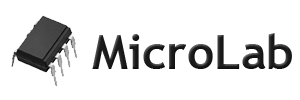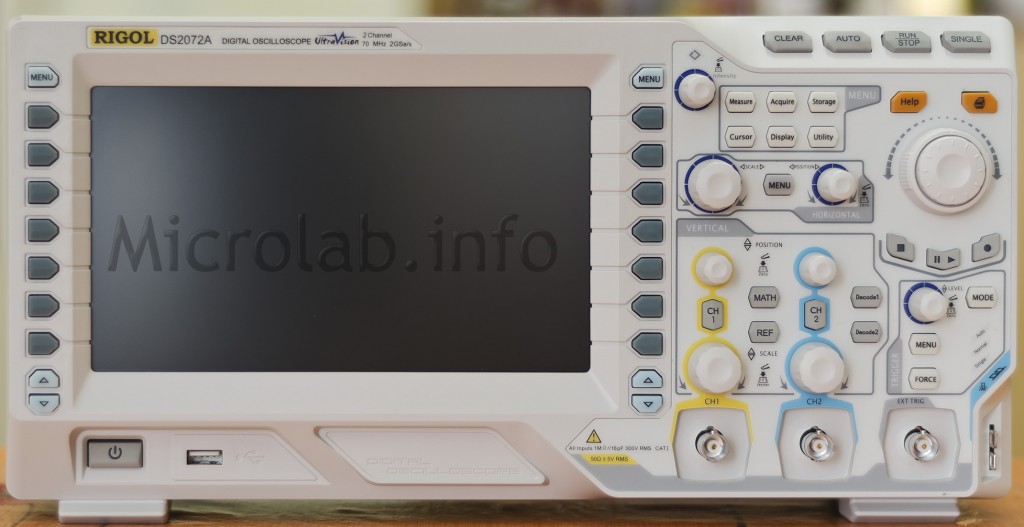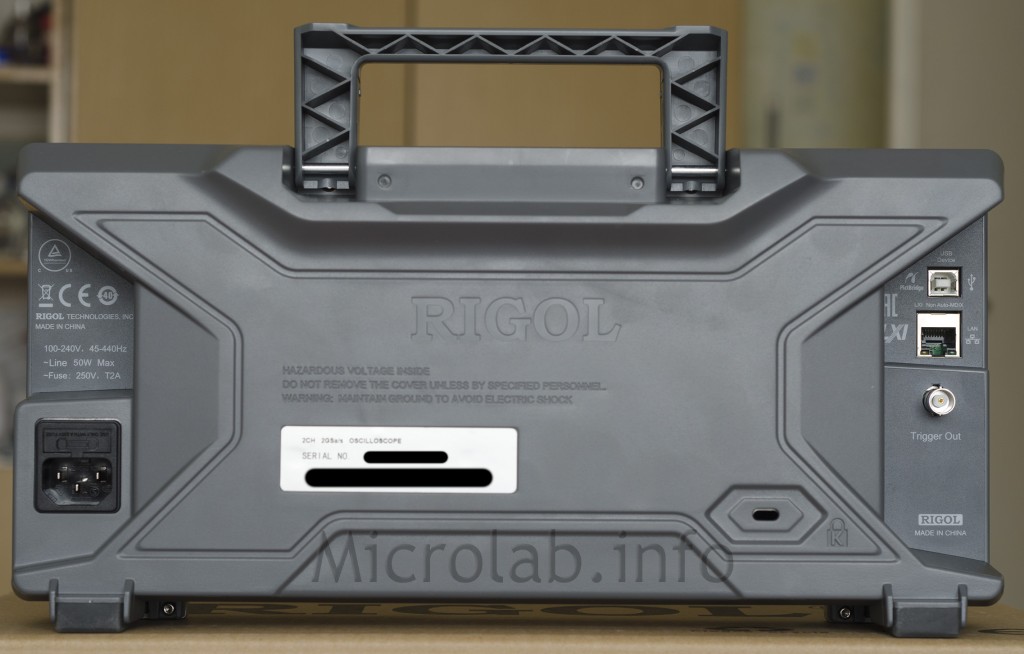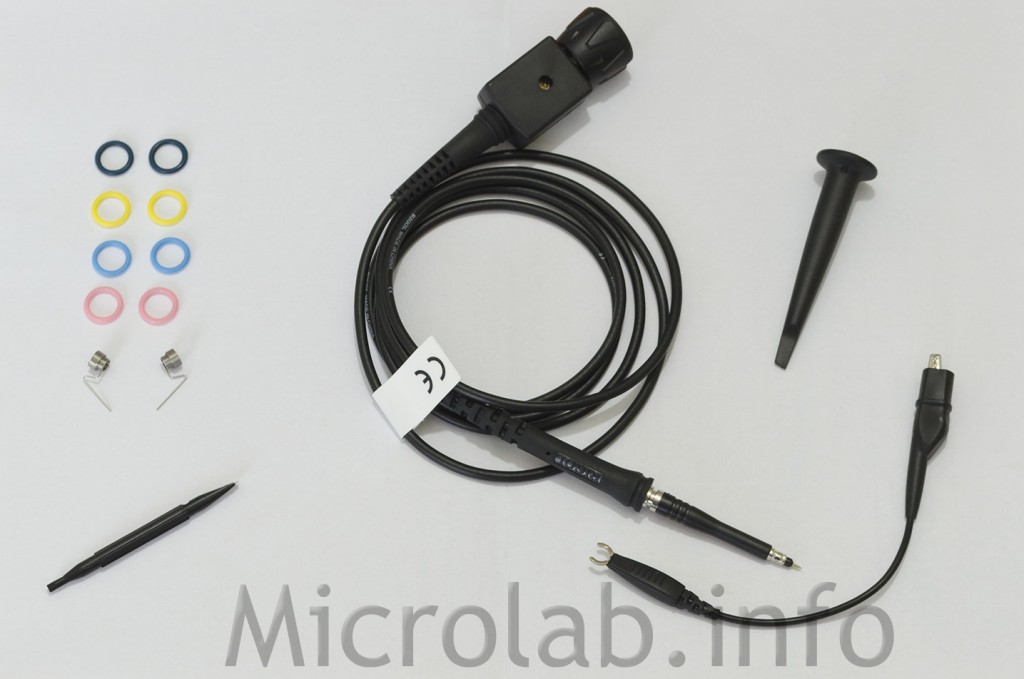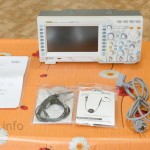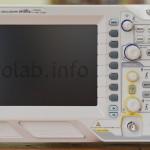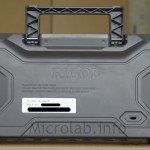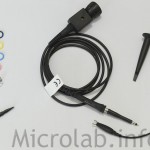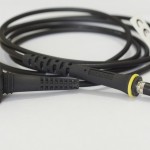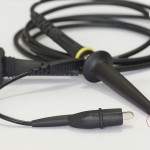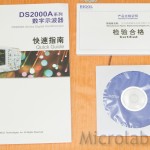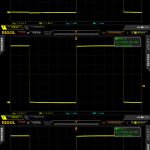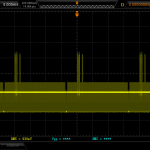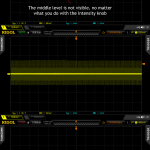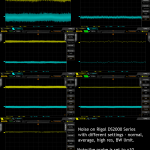I just received the Rigol DS2072A (the new version of the DS2000 series) oscilloscope and I though I can share my first impressions. It’s not a complete review because the good and bad sides I’ll mention are not actually tested in details to see how they interfere with the work process. I’ll probably post more detailed review after I spend more time working with the scope.
Have a look
The oscilloscope came in 2 boxes (I’ve put a link to an unpacking video I found in youtube in the links section) to provide extra protection. There is a list of package contents so you can check if something is missing. What surprised me is that Rigol provide a calibration certificate. I’m not sure if they did that for the older DS2000 series.
Here is a hi-res photo of the oscilloscope (click to open):
Since it has a bigger screen than the DS1000x series there is less space for controls, so the horizontal is above the 2 channels’ vertical controls. It’s a bit strange but I might get used to it later. The big record scroll knob is what I put my hope on. It should help a lot when trying to capture small bursts separated by long periods of “silence”. The function keys beside the display are on both sides and they are quite a lot. It’ll be easier to navigate the menus. The left side function keys are dedicated to measurements and are not user programmable. There are dedicated page up/down knobs, so switching menu pages no longer occupies function button.
On the back there is a LAN (great!), USB device, trigger/pass-fail out and power connectors.
The scope comes with two 300 MHz 10x (fixed) passive probes:
First impression
I read few reviews before I buy the oscilloscope and I knew about some of the issues with it. The loud fan is as loud as they say in all the reviews and videos out there. They didn’t do any changes on it compared to the non-A series.
The probes are quite small to handle and this is bad and good. Bad because well you can’t easily handle them and good because it’ll apply less pressure on your PCB when you hook them. If they have made the tip sorter and the “handle” longer it would be easier to handle. I still don’t know if the size will get in the way when I’m working with it. The color rings are rubber and they don’t really stay in place. I used plastic rings from my other pair of cheap probes. The little springs that are used for high frequencies are a bit too long (checkout the photos) and it’s hard to probe two points close to each other. I’ve cut one of them and now I can use them just fine. They are steal and they are not coated with something to ensure better contact, but I didn’t have any problems using them.
The hook tip can easily get stuck outside. I fixed this by bending them a bit backwards and now they work a bit better, but not quite the best. Well I don’t use the hooks that much. From my experience I often forget to remove the probe when I solder and the hooks melt. That’s why most of the time I’m using my cheap 60 or 100MHz probe that you can get on ebay for 5-6 USD and when I need to measure really high frequencies I use the rigol probes which the spring attachment. So I don’t use rigol probes with hooks that much.
The probes are fixed 10x, so if you want to measure at the lowest possible range of 0.5 mV you’ll have to get a 1x probe.
The controls work nice. I feel like there is not enough acceleration on the fine rotary encoders when you rotate it fast if it accelerates at all. Actually I think it might be missing ticks if you rotate it too fast. However the good news is that when you try to adjust them fine it’s really precise. Having precise controls saves more time than slow controls waste. I kinda got used to it and now I appreciate that it’s easy to set it precisely to desired values.
The recording controls are almost good except for the rotating knob. You can get crazy while trying to scroll one frame at a time. Sometimes it jumps by 2 or even 3 frames. There is no clear clicking while rotating and you can make it sit between positions. If you rotate it slowly the accuracy get worse. If you rotate it faster – you can’t stop precisely where you want. The spring knob is really nice when you want to scroll fast. you can really control the speed, but you can’t use it to scroll frames one by one. it’s not that precise. So the recording controls are good for recording, but not quite for playback, unless you want to see sequence of all the frames fast. But the idea of recording is usually to watch the frames slow because you can have the frames moving fast without recording. So big disappointment here.
It’s really nice that they’ve put trial period for previewing all possible options. I feel like this is the right way to give me confidence to buy an option. However I run into a possible bug on one of the options. Decoding is not done on the recorded data. Well that’s like half of the reasons why you would want to record a digital signal – to decode it. So I probably won’t buy the serial decoding until I get an answer that this is fixed.
Another bug I found with the recording is that when you put the trigger in “normal” mode the first trigger gets offset time of 0.000000s even if it triggered 10 seconds after the push of the record button. So I press the record button, 2 seconds later I send 3 bursts of serial data with distance 10-20ms between them and first frame gets offset 0, second gets offset 2 and something seconds, the third is 20ms away from the second. Part of the problem is that the timer starts on pushing the button and not on the first trigger which is the actual thing you want to measure. You don’t care how far the second frame is from pushing the button. Instead you would want to know the time between first and second trigger. I’m pretty sure that the same is valid for auto trigger except that the auto trigger records even when there is no trigger. Even in that case the time of second frame is offset from pushing the button and not from the first trigger which might be different.
I thought decoding option is great and I was ready to buy it. Well it’s not that great. As a start it doesn’t work that well in normal trigger mode – the numbers disappear and only appear for a split second while you turn horizontal knob and they disappear again … which is strange, but still not the end of the world. What makes it really bad is that it doesn’t work on recorded data. What? Well that’s the most useful feature in a 50 000 wfps scope (probably a bit less in recording mode) with built in serial decoding. I thought how awesome it would be to have that dedicated record control and scroll through your packets and actually see the data decoded, but no, doesn’t work that way. You can still get your 3-4 bytes of decoded data on screen in auto and single trigger modes if you are really willing to pay 188 EUR for it. Well it’s useful. It would be bad if you didn’t have any decoding, but is it worth 188 EUR … I don’t know.
Math is really bad. Even though you have a flexibility to build your own complex formula in math mode it is extremely slow. Actually it’s 5 times slower than my Axiomet AX-DS1022C cheap, crappy oscilloscope even in a-b or a+b mode. Yes simple subtraction takes about a second to refresh and all that you do – moving the form around, scaling it, changing parameters, appear on screen a second later. Probably $100 pocket oscilloscope will do better than that. So math, including FFT is crap. Doesn’t really work with that slow refresh rate.
Did I scare you. Well yes, there are probably even more bugs that are still not fixed. I found the 2 bugs above for half an hour playing with the scope. But that doesn’t mean that the oscilloscope is bad. The analog like feel of the display is remarkable. You can’t really bring the brightness down as in an analog oscilloscope, but that is now always bad – if the brightness is down all the way you could miss something. The scope is fast and responsive (except menu navigation which has 0.5 seconds of lag). All the functions are intuitive and if you used a scope before you don’t have to check the manual for every common feature. Measurements fit nicely below the signal display, not like on other scopes where you can’t see the wave if you put more than 3-4 measurements. It has a clock on the bottom right corner so you don’t get an “why are you always late for dinner” conversation with your wife. I really hope that they fix the bugs soon, because some of them are the reason I sacrificed the two more channels that I would get with DS1000Z oscilloscope for the better usability of DS2000.
If it wasn’t small amount of memory and the slow boot time I would buy the Agilent’s X2000 series scope. I don’t know why they’ve put only 1Mpts memory (or 100kpts without the option) in it. Rigol’s 14Mpts (without the option) beats the crap out of it. And you might think that you rarely use it. Well I use it a lot. Instead of zoom and retrigger again to see your signal you can just zoom out, single shot and then view all the details of your signal. It’s very helpful not only with digital signals, but analog too. You capture a signal, you se a glitch or a problem with the waveform and you zoom in to see what does it look like. The slow boot time of Agilent’s X2000 wouldn’t be a problem if you are using the scope full day, all the time. but if you need to turn it on for a while 3-4 times a day … that’s annoying.
One bad thing is that the oscilloscope resets back to defaults when you do the calibration procedure. That includes defaults for all features. It’ll put your probes to x1, stop sound (I like beeping), everything. Someone on EEVBlog wrote a program to save your settings and restore them later. That might be useful.
Update: Or just use the save settings function in storage menu :).
Is there anything good about this scope?
Ok. Some nice things about the Rigol 2000 series scopes. The print button (can be setup tp) saves a image in your flash drive and you don’t have to “type” a name. It uses auto-numbering. Great! It might be a common thing on most scopes, but my Axiomet AX-DS1022C didn’t have it and I had to manually backspace, and select next number and I have to remember what the previous number was in order to save a screenshot.
Another good thing is the “big spring knob”. It works on some values that you usually change with your intensity knob. Let’s say that you want to set trigger holdoff to 5ms. If you want to rotate the intensity knob it will take ages to go from 100ns to 5ms. With the spring knob you can do that easily. It is a bit tricky, but once you get used to it you can set values really fast.
Some people talk about the noise at 0.5mV. Of course it’ll be noisy. You can’t expect same high frequency performance at 0.5mV. There are ways to reduce the noise – averaging, BW limit, high-res mode. There is some DC offset – about 1/10 to 2/10 divisions at 500uV range which calibration doesn’t fix, but I still think sometimes it’s useful to have this, especially with 10x probes.
The pass/fail feature is nice. I tried it once or twice with a rotary encoder. I was trying to see how often it’ll make a glitch (fake pulses). I turned on beeping on fail and it was quite easy to notice the frequency of fails by hearing the beeps.
The triggers work really nice, even thought I haven’t used the majority of them… The RS232 trigger works really nice. Just make sure to set everything – like polarity for example. “Normal” does not mean the standard RS232. Normal actually means high for “1” and low for “0”. In RS232 it’s reversed so you would most of the times use “invert” for the polarity option. The Nth edge trigger works fine, but you need a gap before the first pulse which is larger than the pulse period. In fact there is a good explanation in the help – press the function button to set idle time and then press the help button. You’ll see nice help with graphics. It’s a shame they didn’t include this trigger with the basic unit. Why did they put it an option?!? It’s a pretty basic trigger. But you have all the serial triggers… Wierd! And if you have hard times triggering in most cases a single capture with a lot of zoom (thanks to the big memory) will do the job … unless you are searching for some rare glitch or something.
Measurements
It’s a heaven!!! You can add up to 5 (5 or 6?) measurements and they stay below the form, so they don’t get in the way. It’s really fast to pick the required measurement. You can also easily put all measurements on screen at the same time … well it will be in the waveform area, but we are talking about 20 measurements (exactly). And you can measure Ch1, Ch2 and Math. Yes you can make your poor man differential probe using math CH1-CH2 which will be bad and slow, but you can do measurements on it.
Other stuff
Because you have only 2 channels you might want to store reference forms and do few single shots of the signal to capture full 8 bit parallel signal on screen, because you can have up to 10 reference waveforms on screen. You don’t have zoom on references, but this is an oscilloscope, not a magic wand that makes your wishes come true. Of course it would be nice if references supported intensity grading, but they don’t. So if you are writing documentation about a device that has parallel bus with up to 12 bits (10 references + 2 channes) and you don’t have logic analyzer you can still make a snapshot of the bus on screen. It’ll take a while, but at least you can do it. And they ruined it again – 10 references, but only 5 colors which you can choose from. Bad! Well I can live with that.
Final thoughts
So am I sorry for buying this scope? Definitely no. It’s nice oscilloscope and it’s pleasure to work with it. However a lot of the features that are advertised are not quite as good as I wish them to be. Some are only software issues and I really hope they fix it with next update.
